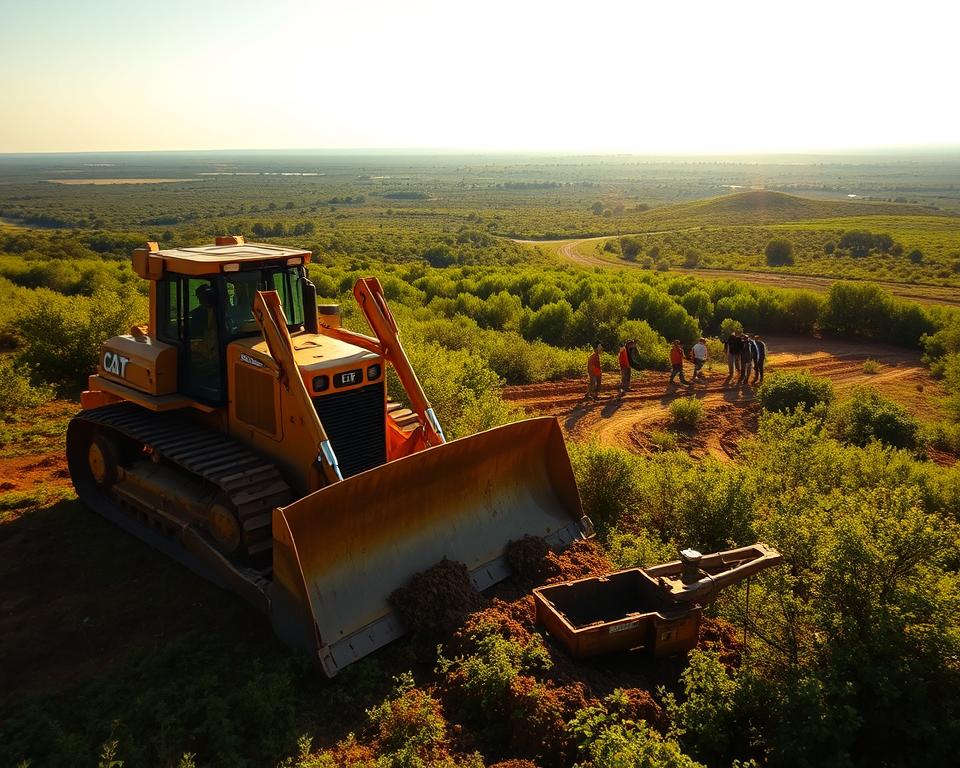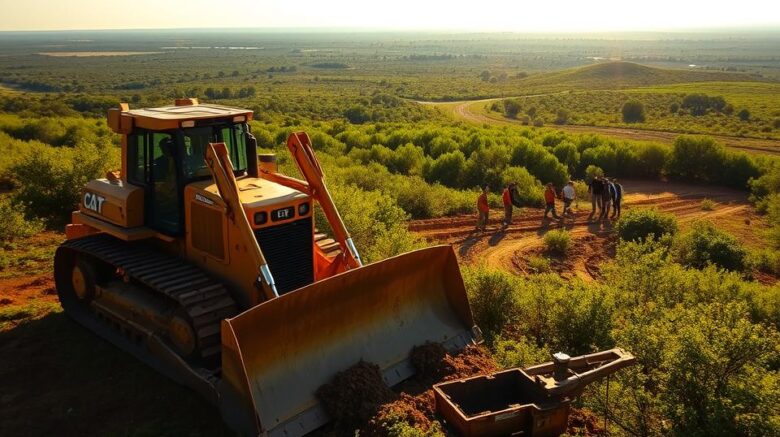Land Clearing Around Water Sources: Prime Techniques
Not many people realize that nearly seventy percent of the world’s freshwater resources suffer threats from farm runoff and Land Clearing? Such a sobering number calls attention to the immediate requirement for responsible land management, essential during water source Land Clearing. Ensuring environmental stewardship is vital for upholding ecological balance and preserving aquatic purity and wildlife habitats. As communities face growing demands on resources, embracing sustainable land management practices is vital. This approach promotes project success while mitigating soil erosion and minimizing pollution threats in aquatic ecosystems – land clearing services.
Notable Observations
- Sustainable land management is essential for protecting water quality.
- Embracing best practices reduces soil erosion and habitat loss.
- Awareness of environmental impacts is critical for responsible Land Clearing.
- Thoughtful planning boosts project success while protecting ecosystems.
- Applying effective techniques encourages biodiversity in aquatic landscapes.
Understanding the Importance of Sustainable Land Clearing
Land Clearing is not limited to plant removal. It has ecological effects of Land Clearing that can harm areas around it, mainly near water. Standard techniques frequently result in soil erosion, ecological disturbance, and water pollution. Understanding these effects is key to implementing improved land management.
Ecological Effects of Conventional Land Clearing
Typical Land Clearing practices can lead to various environmental challenges. Loss of vegetation results in soil erosion, soil degradation, and sediment runoff into aquatic systems. These sediments pollute water, affecting aquatic ecosystems. It also threatens local wildlife and disrupts the ecosystem’s balance.
Eco-friendly Land Management Alternatives
Embracing sustainable land management practices addresses issues caused by conventional clearing. Selective clearing, where specific plants are removed, preserves ecosystem balance. Applying erosion control tactics, including cover crops, fortifies soils and maintains water quality. Prioritizing native vegetation supports wildlife and improves ecological health.
Top Best Practices for Land Clearing
Successful Land Clearing starts with a deep understanding of environmental factors. Assessing environmental objectives is critical to guarantee clearing efforts are sustainable and impactful. Setting distinct goals enables landowners to harmonize environmental conservation and development.

Assessing Your Environmental Goals
Prior to initiating any clearing work, evaluating environmental goals is vital. It requires examining the local ecosystem and clearing’s potential impacts on fauna, soils, and water. Defining personal objectives aids in crafting strategies to safeguard local habitats and watersheds.
Timing Your Clearing Efforts
The timing of Land Clearing is key to its success. Winter and early spring are ideal, as the ground is frozen, reducing soil disturbance and erosion risks. Understanding avoidance periods results in healthier landscapes and diminished environmental impact.
Evaluating Local Regulations and Permit Requirements
Adhering to local Land Clearing rules is essential for project success. Understanding permit requirements can avoid legal issues or fines. Checking ordinances around protected sites ensures compliance and avoids disasters.
Land Clearing Near Water Sources: Best Practices
Effective Land Clearing practices around water sources focus on protecting sensitive areas while ensuring ecological balance. This comprehensive method entails pinpointing areas needing extra care and applying suitable erosion control measures. These measures are essential for safeguarding biodiversity and upholding water purity.
Identifying Sensitive Areas that Need Protection
Prior to Land Clearing, evaluating the terrain for sensitive sites—like wetlands and riparian strips—is crucial. These zones act as natural filters and refuges for multiple species. By properly identifying these areas, land managers can devise strategies for protecting sensitive areas during and after the clearing process.
Enforcing Erosion Mitigation Measures
After identifying critical areas, using erosion control tactics prevents sediment from entering water bodies. Using silt barriers, buffer strips, and cover crops greatly aids in water quality protection. Combining sustainable clearing and erosion controls promotes a robust ecosystem near water sources. This ultimately benefits both the environment and local communities.
Mechanical vs. Manual Land Clearing Methods
Selecting mechanical or manual clearing is key. Each approach offers pros and cons regarding environmental impact and process efficiency. Recognizing these variations enables informed decision-making aligned with management aims.
Pros and Cons of Mechanical Clearing
Using heavy machinery, mechanical clearing quickly removes trees, shrubs, and rubbish. It speeds project timelines and reduces manual labor requirements. Nevertheless, machinery can disrupt soils, compact earth, and negatively impact ecosystems.
- Pros: Rapid clearing of expansive zones.
- Decreased labor requirements.
- Suitability for challenging terrains.
- Drawbacks: Heightened environmental footprint.
- Potential for soil erosion.
- Threat of habitat loss.
Benefits of Manual and Selective Clearing
Manual, selective clearing prioritizes ecological preservation. They use skilled labor for targeted removal, minimizing soil disturbance and preserving plant species. This approach suits projects where biodiversity and ecosystem health are priorities.
- Benefits: Preservation of native vegetation.
- Reduced soil disturbance and erosion.
- Strengthened habitat protection for fauna.
Methods for Wetland Clearing
Wetland ecosystems are remarkable environments that play a vital role in maintaining ecological balance. They purify water, mitigate flooding, and serve as habitats for diverse life forms. Grasping wetland ecology is critical for responsible clearing. The objective is to lessen disruptions and maintain these aquatic habitats.
Understanding Wetland Ecosystems
Wetland ecosystems are characterized by their unique hydrology, soil types, and vegetation. They serve as transitional zones between terrestrial and aquatic environments, supporting a variety of wildlife. They maintain water quality through filtration systems that eliminate pollutants. Preserving their integrity contributes to overall biodiversity and ecological resilience.
Techniques for Responsible Wetland Clearing
Careful planning and precise execution underpin responsible wetland clearing. Techniques that promote ecological sustainability can mitigate the negative impacts of Land Clearing. Commonly used strategies include:
- Staged Clearing: Conduct clearing in phases to minimize ecological disruption, allowing time for wildlife to adapt.
- Targeted Clearing: Remove only specific vegetation types, preserving critical species for habitat stability.
- Regrowth Practices: Introduce practices that encourage natural vegetation regrowth after clearing, maintaining ecosystem functions.
- Establishing Buffer Areas: Establish buffer areas around sensitive wetland sections to protect aquatic habitats from disturbances.
Adopting these techniques ensures that responsible wetland clearing supports the ecological functions wetlands provide while reducing the risk of habitat destruction.
Riparian Reserve Protection Strategies
Riparian reserves are vital for maintaining healthy aquatic ecosystems. Positioned beside rivers and streams, these zones function as protective buffers. They safeguard water quality and enhance biodiversity. By adopting best practices, land managers can prevent erosion, protect wildlife habitats, and preserve waterway ecological integrity.
Importance of Riparian Buffers in Aquatic Ecosystems
Riparian zones play a vital role in aquatic ecosystems. They filter pollutants, stabilize shorelines, and provide habitats for various species. They serve as barriers that lessen human impact on aquatic systems. Preserving these zones boosts water quality and supports fish and aquatic life, enhancing ecosystem resilience.
Best Practices for Maintaining Riparian Zones
To keep riparian reserves effective, several best practices are essential:
- Avoid construction within buffer strips to minimize disturbance.
- Use native vegetation to stabilize banks and prevent erosion.
- Establish a diverse plant community to enhance habitat complexity and support wildlife.
- Manage invasive species to protect native plants and maintain ecosystem stability.
- Regularly assess soil health and water quality to guide management efforts.
Aquatic Land Clearing Essentials
Aquatic land clearing strategies are vital for ecological balance and healthy water systems. Ensuring water quality control during clearing cuts pollution threats and fosters sustainability. These approaches mitigate sedimentation and enhance aquatic ecosystem health.
Water Quality and Sediment Management Tactics
Proper water quality control begins with evaluating local water systems. Clearing adjacent to water systems must avoid sediment deposits that damage water quality and aquatic organisms. Key strategies include:
- Establishing buffer zones to filter pollutants
- Using sediment traps and barriers to minimize runoff
- Selecting clearing times to coincide with low water levels
These methods protect water quality and maintain ecosystem integrity. Retained vegetation helps control sediments and cycle nutrients, resulting in healthier water systems.
Aquatic Biodiversity Protection
Maintaining biodiversity in aquatic landscapes is key for resilient ecosystems. Aquatic land clearing should preserve native species, which are vital for these habitats. Practices to enhance biodiversity include:
- Conserving critical habitats during clearing processes
- Implementing phased clearing to allow wildlife adaptation
- Restoring natural vegetation post-clearing to enhance habitat
By adopting these measures, land managers can foster biodiversity in aquatic landscapes. This leads to more robust and adaptable ecosystems. Such efforts protect waterway health and support sustainable land-use practices.
Stream Bank and Riverbank Clearing Insights
Clearing stream banks poses unique challenges, requiring attention to ecological impacts and regulations. Respecting riverbank guidelines is vital to maintain water source ecosystem balance. Erosion, habitat loss, and water quality degradation necessitate strategic mitigation during clearing.
Obstacles in Stream Bank Clearing
Stream bank clearing faces numerous hurdles. Erosion poses significant risks, leading to soil depletion and declining water quality. Habitat disruption endangers fauna dependent on riparian habitats. Without plants, stormwater runoff surges, depositing sediments in watercourses. Such problems underscore the importance of managing stream banks effectively.
Mitigating Erosion and Supporting Healthy Flora
Erosion control is essential in stream bank clearing. Introducing native plants stabilizes stream banks. Roots curtail erosion, supporting a resilient environment for adjacent flora and fauna. Periodic reviews in clearing guarantee efficacy and preserve riverbank ecology. Lush vegetation advances management objectives and sustains ecosystem health.
Conclusion
Applying optimal practices for clearing near water sources is vital for ecosystem health. Stakeholders need to prioritize sustainable land management. This approach not only fulfills their goals but also protects the environment. Strategic planning and execution help protecting aquatic ecosystems and biodiversity during clearing.
Spotting vulnerable areas and employing erosion measures are crucial steps. Employing both mechanical and manual clearing methods helps landowners and contractors achieve responsible land management. Eco-friendly practices promote a balance between human activities and nature. This keeps water sources and nearby landscapes healthy and robust.
The commitment to sustainable land management is a collective responsibility. Every action during Land Clearing operations impacts watershed health. By integrating environmentally responsible practices, we can create a future where agriculture and the environment coexist harmoniously.
